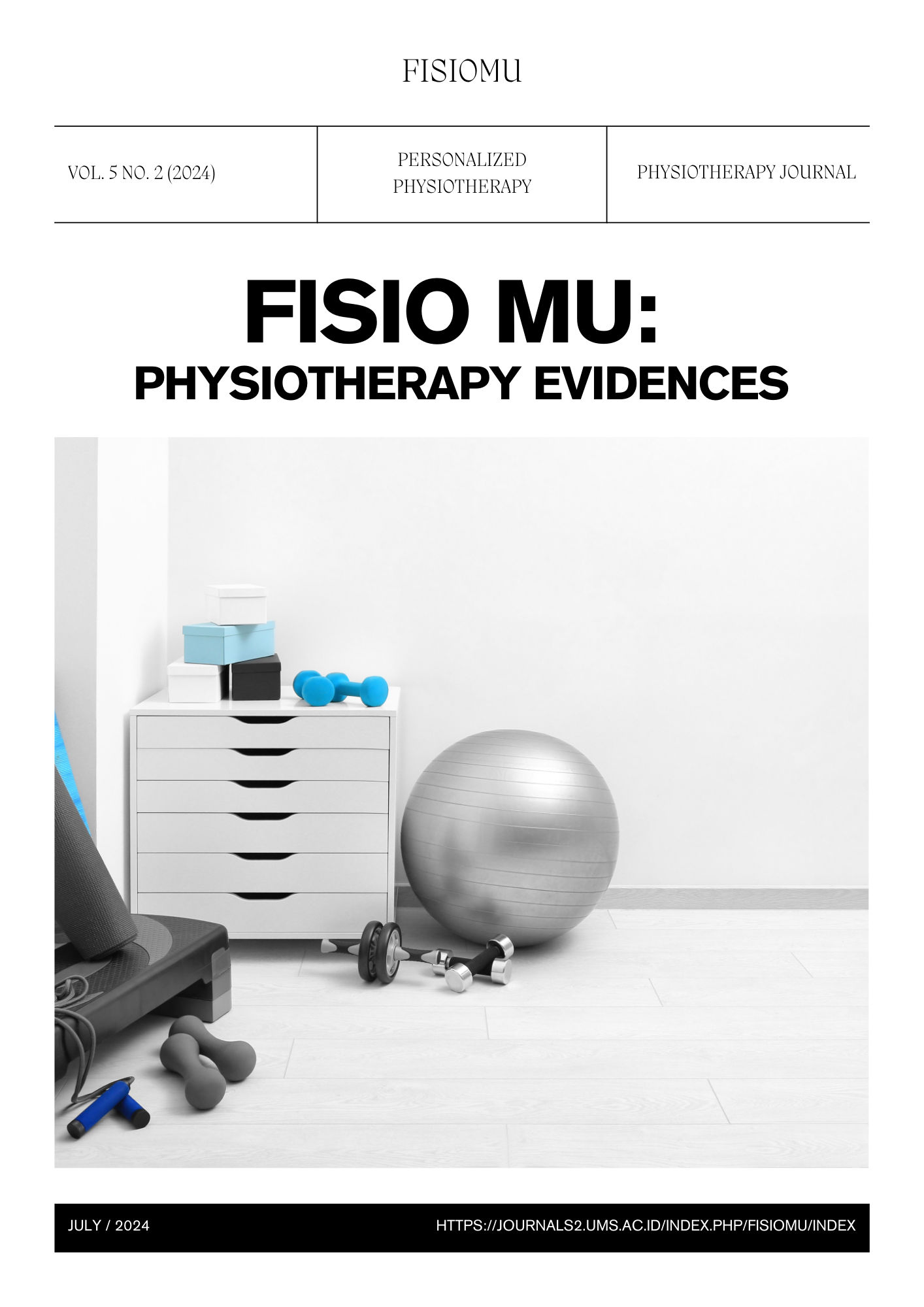The Hemiplegic Shoulder Pain: A Descriptive Study
DOI:
https://doi.org/10.23917/fisiomu.v5i2.4887Abstract
Introduction: Stroke is the number one cause of disability and the number three cause of death in the world after heart disease and cancer in both developed and developing countries. The disorder that often occurs is weakness in the upper extremities with the main complication being shoulder disorders. Hemiplegic Shoulder Pain (HSP) is one of four complications that often occurs in stroke patients. Research in several countries reports HSP rates of more than 65%. The diagnosis of HSP is difficult to make and is often used to describe a complexity of shoulder problems. Many factors influence the occurrence of HSP, such as immobilization, shoulder impingement, subluxation, spasticity and neuropathic pain. The consequences of HSP are decrease in the functional ability of upper extremity and disturbances in comfort and even sleep disorders which will reduce the quality of life. Physiotherapists play a role in preventing and providing interventions for HSP conditions. Clinical data on the incidence of HSP and the risk factors that cause it are needed to create a comprehensive HSP prevention program and intervention plan. To determine the incidence of HSP and its risk factors in post-stroke patients. Method: This study used descriptive method with a case study design using questionnaires and physical examination. The research subjects were chronic stroke sufferers with onset less than 1 year, totaling 78 people. The questionnaire used contains questions about history of stroke and other conditions related to stroke and shoulder pain. The physical examination and measurements used are the Shoulder Pain and Disability Index (SPADi) to assess the level of pain and disability and the Fugl Meyer Assessment for Upper Extremity (FMA-UE) for upper extremity functional ability. The research was conducted at the Mahar Mardjono National Brain Center Hospital, Jakarta from August to September 2023. Results: This study shows that 77% of stroke sufferers experienced HSP and there was a significant relationship between HSP and levels of pain and disability (p=0.000) as well as decreased upper extremity functional ability (p=0.050). Conclusion: HSP is a complication that often occurs in stroke sufferers and can affect the level of pain and disability and upper extremity functional ability.
Downloads
References
Adey-Wakeling Z, Arima H, Crotty M, et al. Incidence and associations of hemiplegic shoulder pain poststroke: prospective population-based study. Arch Phys Med Rehabil. 2015 Feb. 96 (2):241-247.e1
Adey-Wakeling Z, Liu E, Crotty M, et al. Hemiplegic shoulder pain reduces quality of life after acute stroke: a prospective population-based study. Am J Phys Med Rehabil. 2016;95(10): 758–763.
Anwer S, Alghadir A. Incidence, prevalence, and risk factors of hemiplegic shoulder pain: a systematic review. IJERPH. 2020;17(14):4962.
Badan Litbangkes. (2018). Laporan Provinsi DKI Jakarta: Riskesdas 2018. In Laporan Provinsi DKI Jakarta. https://www.litbang.kemkes.go.id/laporanriset-kesehatan-dasar-riskesdas
Bot SD, Terwee CB, van der Windt DA, Bouter LM, Dekker J, de Vet HC: Clinimetric evaluation of shoulder disability questionnaires: a systematic review of the literature. Ann Rheum Dis. 2004, 63 (4): 335-341.
Brandstater EM. Stroke rehabilitation. In: DeLisa JA, Gans BM, editors. Physical medicine and rehabilitation. Principles and practice. 4th ed. Philadelphia: Lippincott Williams and Wilkins; 2005. p. 1655–1676.
Coskun Benlidayi, Sibel Basaran Practical Neurology 2014, 14 (2): 88-91
Gladstone DJ, Danells CJ, Black SE. The Fugl-Meyer assessment of motor recovery after stroke: a critical review of its measurement properties. Neurorehabilitation and neural repair. 2002 Sep;16(3):232-40
Holmes RJ, Connell LA. A survey of the current practice of intramuscular botulinum toxin injections for hemiplegic shoulder pain in the UK. Disab Rehab. 2019;41(6):720–726.
Holmes RJ, McManus KJ, Koulouglioti C, et al. Risk factors for poststroke shoulder pain: a systematic review and meta-analysis. J Stroke Cerebrovasc Dis. 2020;29(6):104787.
Janus-Laszuk B, Mirowska-Guzel D, SarzynskaDlugosz L, et al. Effect of medical complications on the after-stroke rehabilitation outcome. NeuroRehabilitation. 2017;40(2):223–232.
Karaahmet OZ, Eksioglu E, Gurcay E, et al. Hemiplegic shoulder pain: associated factors and rehabilitation outcomes of hemiplegic patients with and without shoulder pain. Top Stroke Rehabil. 2014 May-Jun. 21 (3):237-45
Palastanga N, Field D, Soames R. Anatomy and human movement: structure and function. 2nd ed. Oxford: Butterworth-Heinemann; 2013.
Vasudevan JM, Browne BJ. Hemiplegic shoulder pain: an approach to diagnosis and management. Phys Med Rehabil Clin N Am. 2014;25(2):411–437.
Viana R, Pereira S, Mehta S, et al. Evidence for therapeutic interventions for hemiplegic shoulder pain during the chronic stage of stroke: a review. Top Stroke Rehabil. 2012;19(6):514–522.
Yi Y, Lee KJ, Kim W, Oh BM, Chung SG. Biomechanical properties of the glenohumeral joint capsule in hemiplegic shoulder pain. Clin Biomech (Bristol, Avon). 2013 Oct. 28(8):873-8
Zoe Adey-Wakeling, Hisatomi Arima, Maria Crotty, James Leyden, Timothy Kleinig, Craig S Anderson, Jonathon Newbury Archives of Physical Medicine and Rehabilitation 2015, 96 (2): 241-247
Downloads
Submitted
Accepted
Published
How to Cite
Issue
Section
License
Copyright (c) 2024 Fisio Mu : Physiotherapy Evidaces Journal

This work is licensed under a Creative Commons Attribution-NonCommercial-NoDerivatives 4.0 International License.

This work is licensed under a Creative Commons Attribution-NonCommercial 4.0 International License.
Authors who publish with FISIO MU: Phsiotherapy Evidences agree to the following terms:
- Author(s) retain copyright and grant the journal right of first publication with the work simultaneously licensed under a Creative Commons Attribution-NonCommercial 4.0 International License that allow others to share the work within an acknowledgement of the work’s authorship and initial publication of this journal.
- Author(s) are able to enter into separate, additional contractual arrangement for the non-exclusive distribution of the the journal’s published version of the work (e.g. acknowledgement of its initial publication in this journal).
- Author(s) are permitted and encouraged to post their work online (e.g. in institutional repositories or on their websites) prior to and during the submission process, as it can lead to productive exchanges, as well as earlier and greater citation of published works.












